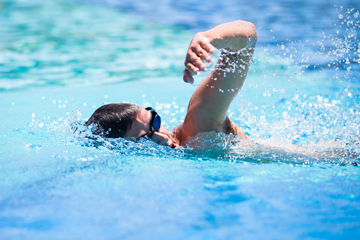Swimming is one of the best options for weight loss. An hour of swimming can help you burn calories and shed excess kilos just as well as weight training or cardio. Swimming regularly offers a host of advantages and this has made it the fourth most popular activity in the United States.

Swimming uses many muscles in the body and the heart and lungs work hard to supply them all with oxygen. So swimming gives the cardiovascular system an excellent workout. Losing weight with regular swimming will improve your health and can also reduce the risk of chronic illness, such as heart disease, type-2 diabetes, and stroke. Swimming increases heart rate without stressing the body, tones the muscles, and builds strength and endurance.
But how does swimming actually help weight loss? When you swim, both large and small muscle groups are used. This can lead to quicker weight loss than other workouts because of the resistance. Water is 800 times denser than air, which makes each kick, push and pull like a resistance workout for your entire body. So, swimming not only burns calories but also helps in building lean muscles which can boost your metabolism and burn more calories. Swimming with resistance is harder than exercising on the treadmill. You can increase and decrease the intensity without stressing your body.
As swimming can be targeted to every area of your body, you can tailor your swimming sessions to exercise specific areas of your body with various strokes such as freestyle, breaststroke, backstroke, butterfly stroke and sidestroke. Each of these various strokes focuses on different muscle groups. You can burn more calories when you swim faster and cover more distance. The ideal strategy is to mix up your strokes and work the most muscles.
If you are swimming to lose weight, here are a few things to keep in mind:
- If you are new to swimming, consider taking lessons under experts.
- Swim only in areas that are allowed for swimming such as pools and roped off sections of lakes and other bodies of water. If possible,, swim in areas that are supervised by lifeguards.
- Swimming outdoors can cause skin problems, so take proper precautions. To avoid skin burn, wear sunscreen of at least SPF 15 or higher and avoid swimming between the hours of 10 a.m. and 4 p.m. when the sun is highest in the sky.
- Stay hydrated even if you aren’t thirsty, as you can get dehydrated while swimming.
Finally, if you choose swimming as your main workout, you should balance it with the right diet with enough of vitamins and minerals on a daily basis.